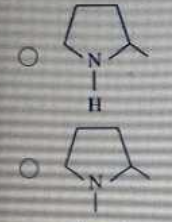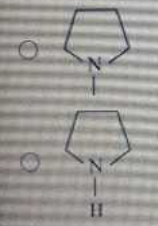An ideal solution is obtained by mixing CH3CHBr2 and CH2Br−CH2Br in the ratio 2 : 1 P∘CH3CHBr2=173,P∘CH2BrCH2Br=127. Thus total vapour pressure is
158
257
137
197
The correct Answer is:A
To solve the problem of finding the total vapor pressure of an ideal solution formed by mixing CH3CHBr2 and CH2BrCH2Br in the ratio of 2:1, we can use Raoult's Law. Here is a step-by-step solution:
Step 1: Identify the Components
We have two components:
- Component A: CH3CHBr2
- Component B: CH2BrCH2Br
Step 2: Given Data
- Vapor pressure of pure CH3CHBr2 (P0A) = 173 mmHg
- Vapor pressure of pure CH2BrCH2Br (P0B) = 127 mmHg
- Ratio of components A to B = 2:1
Step 3: Calculate Moles of Each Component
Let the number of moles of CH3CHBr2 be 2x and the number of moles of CH2BrCH2Br be x.
Step 4: Calculate Total Moles
Total moles (n_total) = moles of A + moles of B = 2x + x = 3x.
Step 5: Calculate Mole Fractions
- Mole fraction of A (xA) = moles of A / total moles = (2x) / (3x) = 2/3
- Mole fraction of B (xB) = moles of B / total moles = x / (3x) = 1/3
Step 6: Apply Raoult's Law
According to Raoult's Law, the total vapor pressure (P_total) of the solution is given by:
\( P_{\text{total}} = P_{0A} \cdot x_A + P_{0B} \cdot x_B \)
Step 7: Substitute Values
Substituting the values we have:
\( P_{\text{total}} = (173 \, \text{mmHg}) \cdot \left(\frac{2}{3}\right) + (127 \, \text{mmHg}) \cdot \left(\frac{1}{3}\right) \)
Step 8: Calculate Each Term
Calculating each term:
- For component A:
\( 173 \cdot \frac{2}{3} = \frac{346}{3} \approx 115.33 \, \text{mmHg} \)
- For component B:
\( 127 \cdot \frac{1}{3} = \frac{127}{3} \approx 42.33 \, \text{mmHg} \)
Step 9: Add the Contributions
Now, add the contributions from both components:
\( P_{\text{total}} = 115.33 + 42.33 = 157.66 \, \text{mmHg} \)
Step 10: Round Off
Rounding off gives us:
\( P_{\text{total}} \approx 158 \, \text{mmHg} \)
Final Answer
Thus, the total vapor pressure of the solution is 158 mmHg.
---
We have two components:
- Component A: CH3CHBr2
- Component B: CH2BrCH2Br
- Vapor pressure of pure CH3CHBr2 (P0A) = 173 mmHg
- Vapor pressure of pure CH2BrCH2Br (P0B) = 127 mmHg
- Ratio of components A to B = 2:1
Let the number of moles of CH3CHBr2 be 2x and the number of moles of CH2BrCH2Br be x.
Total moles (n_total) = moles of A + moles of B = 2x + x = 3x.
- Mole fraction of A (xA) = moles of A / total moles = (2x) / (3x) = 2/3
- Mole fraction of B (xB) = moles of B / total moles = x / (3x) = 1/3
According to Raoult's Law, the total vapor pressure (P_total) of the solution is given by:
\( P_{\text{total}} = P_{0A} \cdot x_A + P_{0B} \cdot x_B \)
Substituting the values we have:
\( P_{\text{total}} = (173 \, \text{mmHg}) \cdot \left(\frac{2}{3}\right) + (127 \, \text{mmHg}) \cdot \left(\frac{1}{3}\right) \)
Calculating each term:
- For component A:
\( 173 \cdot \frac{2}{3} = \frac{346}{3} \approx 115.33 \, \text{mmHg} \)
- For component B:
\( 127 \cdot \frac{1}{3} = \frac{127}{3} \approx 42.33 \, \text{mmHg} \)
Now, add the contributions from both components:
\( P_{\text{total}} = 115.33 + 42.33 = 157.66 \, \text{mmHg} \)
Rounding off gives us:
\( P_{\text{total}} \approx 158 \, \text{mmHg} \)
Thus, the total vapor pressure of the solution is 158 mmHg.
Topper's Solved these Questions
- BOOK - NARAYNACHAPTER - SOLUTIONS & COLLIGATIVE PROPERTIES EXERCISE - EXERCISE : 426videos
SOLUTIONS & COLLIGATIVE PROPERTIES
- BOOK - NARAYNACHAPTER - SOLUTIONS & COLLIGATIVE PROPERTIES EXERCISE - EXERCISE : 2 (H.W)59videos
SOLUTIONS & COLLIGATIVE PROPERTIES
- BOOK - NARAYNACHAPTER - SOLID STATESEXERCISE - EXERCISE-418videos
SOLID STATES
- BOOK - NARAYNACHAPTER - SURFACE CHEMISTRY EXERCISE - EXERCISE - 422videos
SURFACE CHEMISTRY
Similar Questions
Knowledge Check
- Question 1 - Select One
The following compound is obtained when CH3CH2CHBr2 is boiled with aqueous caustic potash:
ACH3−C≡CHBCH3−CH=CHBrCCH3CH2CHODNone of these - Question 2 - Select One
In CH3CH2Br,% of Br is
A80B75C70D7 - Question 3 - Select One
The IUPAC name of (CH3)2)CHCH2CH2Br is
A(1) 1-bromo-3-methylbutaneB(2) 1-bromopentaneC(3) 2-methyl-4-bromobutaneD(4) 2-methyl-3-bromopropane
Iupac name is
CH3−CH2−C(Br)2−CH2−CH2−CH2−ClView SolutionThe systematic name of CH3−CHBr−CH2OH is
View SolutionIn CH3−CH2−CH2−Br,C−Br bond is formed by the overlapping of
View SolutionConsider the reaction :
CH3CH2CH2Br+NaCN→CH3CH2CH2CN+NaBr
This reaction will be the fastest in :View SolutionBr−CH2(CH2)2−Ch2−Br+CH3NH2→ product to the reaction is :
View Solution



